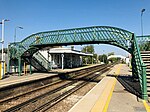The Eastbourne Academy
Academies in East SussexSecondary schools in East SussexSouth East England school stubsUse British English from February 2023
The Eastbourne Academy (shortened to TEA) is a coeducational secondary school with academy status, located in Eastbourne in the English county of East Sussex.Previously known as Eastbourne Technology College, the school converted to academy status in September 2010. It was previously a community school administered by East Sussex County Council. The school continues to coordinate with East Sussex County Council for admissions. The Eastbourne Academy offers GCSEs and BTECs as programmes of study for pupils.
Excerpt from the Wikipedia article The Eastbourne Academy (License: CC BY-SA 3.0, Authors).The Eastbourne Academy
Brodrick Road,
Geographical coordinates (GPS) Address Phone number Website External links Nearby Places Show on map
Geographical coordinates (GPS)
| Latitude | Longitude |
|---|---|
| N 50.8021 ° | E 0.26926 ° |
Address
The Eastbourne Academy
Brodrick Road
BN22 9RQ , Hampden Park
England, United Kingdom
Open on Google Maps






